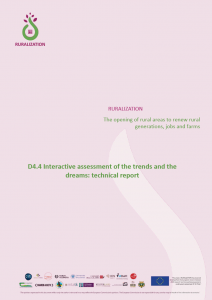
Access to land: resources database

D4.1 Trend analysis technical report – Output #1
Section title: Results

D4.2 Trends database – Output #1
Section title: Trends by Country: Romania
Sub-section/paragraph: Trends Inventory
D4.3 Dreams inventory
Section title: Les nouvelles générations et la ruralité en Europe

D4.4 Interactions technical report – Output #1
Section title: Dortmund regional pofile (Germany)
Highlights: The example is not applicable at all because it touches almost only urban topics.

D4.4 Interactions technical report – Output #2
Section title: Vogelsberg regional profile (Germany)
Highlights: The example is rather less applicable to agricultural developments, but it highlights the infrastructural problems of rural areas.

D4.5 Summary trends, inventory & workshops – Output #1
Section title: Regional profile: Fejér county

D4.5 Summary trends, inventory & workshops – Output #2
Section title: Regional Profile: Midden-Noord-Brabant
Highlights: Informative discussion on who has which responsibilities in Midden-Noord-Brabant

D4.5 Summary trends, inventory & workshops – Output #3
Section title: Regional Profile: Overig Zeeland
Highlights: Interesting discussion with stakeholders who has responsibilities in Overig Zeeland

D4.5 Summary trends, inventory & workshops – Output #4
Section title: Regional profile: Cluj county

D4.5 Summary trends, inventory & workshops – Output #5
Section title: Regional profile: Cluj county

D4.5 Summary trends, inventory & workshops – Output #6
Section title: Regional profile: Jeleniogórski Region
Highlights: The PL515 Jeleniogorski region is an ‘intermediate’ region located in the in the south-west corner of Poland. Some parts of this region are popular among rural newcomers, and there is some functional mix of agriculture with tourism and residential functions of the countryside. Also, the area of and around Jelenia Gora, where one of the Future Dreams workshop was held, is a sub-regional hub relatively popular in the region and the country. Its characteristics make it a good case to compare with a more peripheral region (predominantly rural) located in Eastern Poland where youth’s future dreams were studied too.

D4.5 Summary trends, inventory & workshops – Output #7
Section title: Regional profile: Chełmsko-Zamojski region
Highlights: The PL312 Chełmsko-Zamojski region is a predominantly rural region located in the East of Poland, at the Polish-Ukrainan border. It is a peripheral agricultural region with slow dynamics of land-use change, fragmented farmland and, comparing to the EU, low income levels. The region show tendencies towards net outmigration, demographic problems, slight consolidation of farmland plots, a slow shift towards touristic and recreational functions and recent increases – albeit from a very low levels – of protected areas. In comparison to the other region selected for future dreams assessment, Chełmsko-Zamojski region offers insight into more remote rural dreams and experiences.

D4.5 Summary trends, inventory & workshops – Output #8
Section title: Regional profile: Szabolcy – Szatmár – Bereg

D5.1 Analysis of NC, NE and SC – Output #1
Section title: Chapter 2

D5.2 Case studies and factsheets of 30 promising practices – Agriculteurs, Ruraux, Urbains ; Instaurer un dialogue autour de l’alimentation et du rapport à la nature
Section title: Agriculteurs, Ruraux, Urbains ; Instaurer un dialogue autour de l’alimentation et du rapport à la nature






